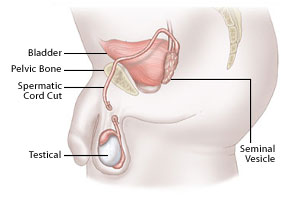Vasectomy Information
Vasectomy is a safe and common form of permanent birth control used for family planning. It is performed in the doctor's office under local anesthesia. By contrast, tubal ligation surgery on the female partner is a more expensive and more invasive procedure. Tubal ligation requires general anesthesia and it is only performed in a surgery center. A survey of doctors who perform vasectomy indicates that they most often choose vasectomy for themselves when their family is complete. It is estimated that more than 600,000 vasectomies are performed in the United States each year.
Traditional vasectomy involves a scalpel cut into the scrotum (sac that holds the testicles) after a local anesthetic has been used to "numb" the sac and to numb the two vas deferens (sperm transport tubes). Each vas deferens tube is cut, a section is removed, and both sides of the cut vas are sealed with sutures, cautery or metal clips. This interrupts the flow of sperm from the testicles into the ejaculation fluid which is called semen. The incisions are then closed with sutures. Open-end vasectomy is a variation on the traditional technique, in which the cut end of the vas on the testicle side is left open without sealing it shut. Some doctors feel that this creates a more reversible vasectomy.
No-Scalpel Vasectomy (NSV)
No-Scalpel Vasectomy (NSV) was developed in China in the mid 1970's. This technique uses two special non-traumatic instruments to provide a quicker, safer and less tender procedure than the traditional vasectomy. It was first performed in the United States in the 1980's. Dr. Buch has used the NSV procedures since 1993, and he is an NSV patient himself. During the NSV, both vasa are accessed through a single small 1/4" entry point into an area of the scrotum that has been "numbed" by local anesthesia. The tiny entry into the scrotum is created by one of two special NSV instruments. The second instrument gently secures the vasa, one at a time, in a spot that has been "numbed". The vasa are then carefully interrupted, and the two ends are sealed with nonreactive metal clips. The small opening in the skin closes by itself due to natural muscle tone in the scrotum. Typically, there is no need for a skin stitch.
Advantages of NSV
- Faster healing
- Less Tenderness
- Lower complication rate
Prior to scheduling your procedure, it is important for you to meet with the doctor for several reasons. Dr. Buch will discuss vasectomy with you to determine which type of procedure is best suited for you. He will take a complete medical history to identify any significant health issues. He will also do a quick and gentle exam to be sure that there are no physical factors that would complicate your procedure. This visit also allows you the chance to be sure that Dr. Buch is the right doctor to perform your procedure.
Prior to the Procedure
- Do not take aspirin, ibuprofen, naproxyn or any medicine known to thin your blood beginning at least 7 days prior to your procedure to minimize blooding risk.
- Please trim or gently shave (dry razor with light touch is best) the hair from the underside of the penis and from the front of scrotum.
- To reduce the risk of infection, thoroughly wash your scrotum and groin areas the day before and the morning of the procedure.
- Two hours prior to the procedure take any prescribed medications as directed.
- Wear clean supportive underwear (jockey style or bikini style briefs) to the procedure.
Related Articles

What are the risks and benefits of having a vasectomy performed? Ask doctor in Frisco clinic
Read More
Dallas area patients ask, does vasectomy reversal work?
Read More
Considering Vasectomy Reversal Surgery? Want To Learn More About Male Fertility?
Read More



